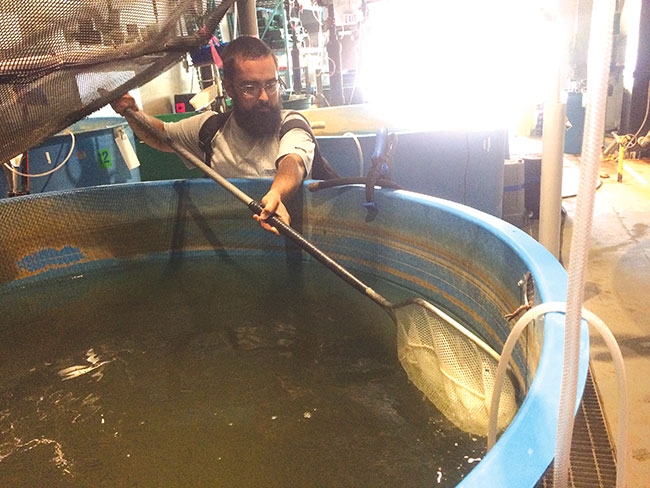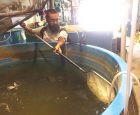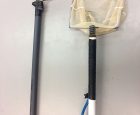
Features
Profiles
The indispensable mort collector
Unglamorous as it may be, mortality collection, classification and analysis are an essential job at any hatchery. Often, mort picking is seen as the bottom end of the job spectrum.
November 5, 2018 By Ron Hill
 Providing the proper equipment Unglamorous as it may be
Providing the proper equipment Unglamorous as it may beNew employees always start with morts because it is simple and other employees are eager to pass the job on. The job tends to be mechanical: morts are removed, counted and dumped in the always stinky mort area. It is too easy to become complacent when picking morts and have a “net, pull, dump” mentality, and see the job as mindless.
Mort picking is generally treated as the worst job – because it usually is. However, its vital importance must not be lost when teaching new employees. Quality mort picking can make or break a group of fish and impact your budget.
Mykolas Kamaitis, veterinarian for Marine Harvest Canada explains: “Mort collection and classification is extremely valuable for fish health management. It may be one of many different tasks you have on the list for any given day, but the information gathered can not only help identify potential fish health concerns but can also help improve the overall productivity of a farm.”
Despite a lack of glory for the mort picker, collection and disposal of morts are a keystone biosecurity measure. Mort pickers are the frontline of fish health and biosecurity. Collecting all the morts in a tank is of the utmost importance.
Sometimes, picking all the tanks can take hours. It is here, when the morts are heavy, that the picker can despair and get tired or frustrated. The quality of picking goes down when it is most essential.
The mort picker must be equipped with two things to succeed – equipment and technique. Equipment seems easy but is often sub par. Go inspect the mort nets at your facility right now and see what kind of shape they are in. Ripped nets and bent poles are often the standard. Does your site have a net for each tank or are too many out of action? Not making it a priority to keep the mort nets in good shape reinforces the perceived inferiority and unimportance of the job by employees.
Mort picking time is also inspection time for the tank. Each employee should go through a quick mental checklist when they pull up to a tank to pick morts (or anytime) and note or correct anything that needs to be addressed.
Supervisors and managers need to reinforce this observation. How were the fish distributed and what condition are they in? Does the tank look clean? Does the flow and spin of the water look correct? Is it clean? This is the chance to make minor corrections and adjustments for optimal water quality or note items to be addressed.
The best techniques for removing morts will depend on your system, tank and life stage. Make sure the best methods are passed on to the new mort pickers.
Here are some general techniques to follow.
- Wear disposable gloves. When picking, don’t let employees use their bare hands to touch the morts as these are potentially the most infectious thing at the farm.
- Pick the moribund fish first. Capture any easy morts first. Don’t chase the moribund ones around if they aren’t easy to catch and stress the rest of the fish in the tank. A good rule of thumb when deciding if a fish is moribund: when in doubt pick it out.
- Concentrate the morts. If possible, consider pulling the standpipe and allow the morts to be sucked toward the screen before picking.
- Consider the live fish. Use a broom to move the live fish in the tank away from the morts if they don’t fear the net. Often, live fish will not fear the mort net as much, making it difficult to see morts and keep the live ones out of the mort net. The pulse of water created by pushing a broom through the water bristles first will usually clear the fish, without striking and removing slime and scales.
- Don’t neglect your mort pickers. Keep rotating pickers and don’t let the same person get stuck with it every day. During heavy days, get another person to help.
Print this page







